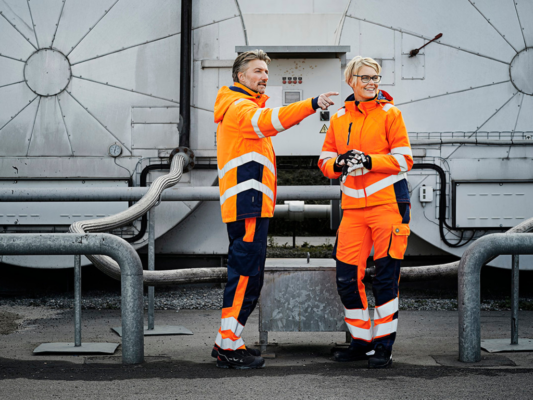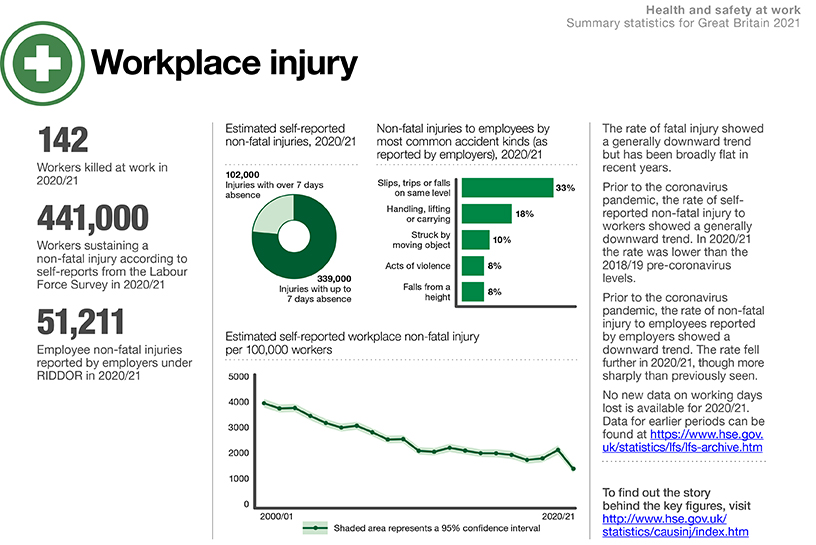No products in the basket.
Health & Safety
How Many Employees Are Injured At Work?
How Many Employees Are Injured At Work?
Sources suggest that the average person makes 35,000 choices per day! Assuming that most people spend 7 hours of their day asleep, that’s roughly 2,000 choices per hour or one decision every 2 seconds. It would be hoped the majority of these moments of judgement lead to favourable outcomes but there will always be those that slip through the net and when it comes to personal safety, that’s a problem! PPE must be a necessity, not just an insurance.
According to the Health & Safety Executive, in the year 2020-2021, 51,211 injuries to employees were reported under RIDDOR (Reporting of Injuries, Diseases and Dangerous Occurrences). Whilst this is an increase on the year below (65,427 – 2019-2020) these figures remain way too high.
Key figures for Great Britain (2020-2021)
1.7M working people suffering from a work-related illness
0.8M workers suffering from work-related stress, depression or anxiety (new or long-standing) in 2020/21
0.5M workers suffering from work-related musculoskeletal disorders (new or longstanding) in 2020/21
93,000 workers suffering from COVID-19 in 2020/21 which they believe may have been from exposure to coronavirus at work (new or long-standing)
0.6M workers suffering from a work-related illness caused or made worse by the effects of the coronavirus pandemic (new or long-standing) in 2020/21
0.4M workers sustaining a non-fatal injury in 2020/21
142 workers killed at work in 2020/21
The statistics shown above indicate the crucial need to take worker safety yet more seriously. The role of protective clothing and Personal Protective Equipment (PPE) in the workplace is fundamental to safeguarding employees and there is an increasing requirement for a more considered approach to PPE management plans.
The key function of all PPE is to reduce employee exposure to health and/or safety risks when engineering or administrative controls are either not feasible or effective to reduce risks to acceptable levels. In a nutshell – it adds an extra layer of protection between the worker and the hazard or between the worker and the environment. The hazards being anything from risks related to heat and flame, chemicals, microbiological agents, mechanical risks and vibrations, to wet conditions, falling debris and everything in between.
Developing an effective PPE management plan that includes addressing the varying risk assessment needs is essential to keeping workers safe. A fundamental step in ensuring compliance with Health and Safety legislation, an effective plan will also include:
- An assessment of the technical needs of the work environment to identify when and where PPE should be worn
- An assessment of the behavioural needs of the employees
- Selection and distribution of the appropriate PPE
- Training sessions and user guides to coach employees in the use, maintenance and replacement of items
- Monitoring procedures to ensure that PPE is being used properly and remains fit for purpose
This systematic process to PPE management will not only help your business prevent work-related injuries and potentially save lives but will also help to ensure you are operating more efficiently and cost-effectively.
So, let’s break this down a little further to identify the steps involved and the varying elements that should be included as part of the decision-making process.
Step 1 – Complete the hazard assessment
All businesses must complete a hazard or risk assessment to consider what could go wrong, and to decide on suitable measures to eliminate, reduce or minimize the risks of loss, damage or injury in the workplace.
Step 2 – Create a safety committee
Your company’s safety committee should be hands on when it comes to creating the PPE management plan, therefore it is always advisable to include both management and staff members within the committee.
One of the most regular complaints our Customer Service Team hear at Clad Safety is that the management or procurement team switched to a ‘cheaper’ version of the existing product when buying replacement items. This was ultimately leading to a whole host of issues downline relating to inferior garment quality and fit. Including the wearers in the decision-making process will help to circumnavigate this issue ensuring the products bought are fit for purpose.
Step 3 – Draft the plan
The exact content of your plan will depend on your company’s needs however some common areas to cover include:
- An explanation of why the plan is necessary and how it will benefit the company
- An outline of who in the company is responsible for actioning each part of the plan (drafting the document, the risk assessment, analysis of the PPE required, sourcing/pricing the items, purchasing and distribution of equipment etc)
- Training guidelines for the use and maintenance of each type of PPE
- Checklists that can be used for monitoring purposes (is the equipment being used and maintained correctly, are adequate supplies in stock, frequency of re-issues etc)
- Policy for garment/equipment disposal (can it be recycled etc)
Step 4 – Put the plan into action
Procurement
When it comes to evaluating the type and amounts of PPE required, it is important to remember that many items can be used in more than one way, making them suitable for multiple situations. Using fewer types of PPE is easier for employees to manage and will also ultimately save the company money in the long run. If you’re unsure what types of PPE work best for each type of job, ask your supplier – a good one will help you find solutions and can provide insights on managing inventory and distribution to assist you in making cost-effective decisions. The earlier you can involve your supplier in the process the better!
It’s important to also remember that whilst price is a factor for consideration, it’s not the only one. Consider the quality of the product you are getting; inferior garments/items lead to more replacements which lead to higher costs in the long run. If you are ordering in large quantities, look for a company that offers wearer trials. Poor fitting workwear and PPE is both uncomfortable and dangerous. An employee can refuse to wear their allocated PPE if it puts their safety at risk, for example if it doesn’t fit correctly, so allowing employees to trial the kit in order to be certain the products you are selecting are favourable, can be hugely beneficial.
Stick to one or two reputable vendors. While it may save money to buy different items from different suppliers it will be much harder to manage in the long-term. When it comes to reordering or if you have any issues, a company’s customer service and delivery record will be just as important, if not more important than the cost.
Invest in training
PPE is simply not effective unless it is used correctly. As part of the training process employees should be made fully aware of the type of hazards each piece of PPE protects against, why and when it should be worn, how to wear it correctly, how to spot issues, the limitations of each item, how to care for and maintain each item (including correct storage) and how to dispose of it. PPE should become a natural part of your company’s safety culture, so it is important not just to train employees in what to do but to communicate why it is important to do it.
Maintaining a record of all employee training in relation to PPE, complete with the date and type of training received is also a vital component in ensuring the company meets its’ legal requirements and objectives.
Step 5 – Evaluation
Whilst some employees can exhibit stubborn habits around the proper use of protective clothing and equipment, a company ethos built around safety and training will undoubtedly assist in buying into its use.
Regular inspections and audits will identify whether items are being used correctly and that they are still in a usable state. The audit procedure should also include checks for practicality and wearability. Where items are deemed unsuitable, a preferable alternative should be sought.
Workplace safety is continuously evolving, yet the figures included above show there is still more work to be done. The shift towards new technologies and innovation is making PPE more comfortable and user friendly. This, when combined with a company ethos of workplace safety produces a visible trend towards increased incident free days.
The earlier you can involve your PPE supplier in the management plan process the better – they will be able to assist you in making the most cost-effective choices and ensure you have the correct items for each job.
Clad Safety has over 30 years of experience, supplying quality workwear and PPE solutions to a wide range of industries and organisations. Our technical team can help guide you in your decisions and offer advice on the range of products in the marketplace. For further information please contact our Customer Service Team on 0800 161 3661 or email [email protected]
This post was updated to reflect 2020-2021 figures. The full document can be viewed here.





